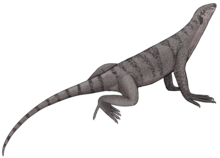|
Araeoscelis
Araeoscelis (from Greek: αραιά araiá, 'thin' and Greek: σκελίς skelís, 'ribs of beef')[1] is an extinct genus of tetrapods from the Early Permian of what is now Texas. Fossils have been found in the Nocona, Arroyo and Waggoner Ranch Formations. Two species have been described, A. casei and A. gracilis.[2] Araeoscelis belonged to the clade Araeoscelidia together with close relatives such as Petrolacosaurus. Araeoscelidia is often considered the most basal group of diapsid reptiles, but some analyses have recovered them as stem-amniotes instead.[3][4] Description Araeoscelis was around 60 centimetres (2.0 ft) long, and superficially resembled a modern lizard. It differed from other araeoscelidians, such as Petrolacosaurus, in that its teeth were larger and blunter; possibly they were used for cracking insect carapaces.[5] Unlike Petrolacosaurus, which possessed the two pairs of skull openings characteristic of diapsids, in Araeoscelis the lower pair of temporal fenestrae were closed with bone, resulting in a euryapsid condition. This would have made the skull more solid, presumably allowing a more powerful bite.[5] IchnologyFootprints found in Nova Scotia have been attributed to Araeoscelis or a close relative.[2] References
Further reading
|
||||||||||||||||||||||||||||||||||
Portal di Ensiklopedia Dunia

